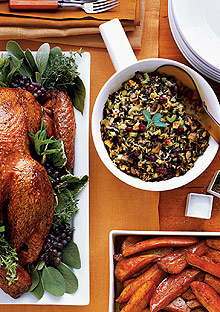No Mean Feast
A Lesson from the Ghost of Glorious Christmas Dinners Past

Photo: Anna Williams
Unlike Thanksgiving, which I approach with the kind of resignation a Sherpa must feel setting out on his umpteenth ascent of Everest, Christmas gives me culinary wanderlust, a desire to go places I've never been, try recipes and piece together menus no sane woman should dare. I suppose I have my mother to thank for this restlessness. From her I acquired an insatiable longing to serve a jaw-dropping, heart-stopping feast on December 25. My childhood Christmases were overlaid with stories and traditions from my mother's Finnish girlhood, like a double-exposed photograph. Most vivid was the description of her mother's—my mummo's—Christmas Eve ham, a dish apparently so glorious that anyone who tasted it devoted the rest of their life to chasing that high. According to my mother, Mummo spent two months brining it, first in lye—"Lye, mom? Isn't that, um, toxic?" "Yes; shhh"—then several changes of water, then salt and sugar and allspice and, in all likelihood, some primitive Scandinavian form of heroin. "It was out of this world," she says.
But I am suspicious. I wonder if her memories of this annual ham are so vivid not just because it tasted great but because ham was not around for the other 364 days of the year. Growing up, my mother's family ate red meat once a week, generally in the form of meatloaf: ground animal's-something-or-other mixed with liberal proportions of bread crumbs or oatmeal, spices, and onion. She was far from malnourished as a girl. She had plenty of milk and herring, plus lingonberries, mushrooms, and whole grains galore. There was always enough food for her family's needs, but no more—no excess, no snacks, no waste, and very little red meat. So perhaps the secret ingredient in Mummo's ham was deprivation, the exaggerated appeal of something keenly anticipated for months on end. Indeed, the only thing my mother and her siblings looked forward to as much as the taste of that ham was the sheer galumphing size of it. "On Christmas Eve, we could have seconds," says my mom, "and even thirds."
All of which is of no help to me whatsoever as the holidays roll around again, because even if I could force my husband and children to renounce snacks and second helpings from October through December, I could never demand such devotion from the rest of my relatives. Besides, the problem isn't just that we aren't hungry enough. It's also that cravings, like all forms of discomfort in 21st-century America, barely have a chance to materialize before they are knocked flat. Whatever it is you want—pork rind, tzatziki, smoked reindeer—you can get it, if not immediately, then by mail order in a matter of days. Longing never has a chance to build.
I suspect that's why my Christmas dinners have grown increasingly outrageous over the years, in an effort to cut through this unremitting satiety. Yet hard as I work, deep down I know it's futile. My mind may be filled with quixotic gourmet dreams, but my gut knows that even the most extraordinary ingredients, high-tech appliances, and sophisticated techniques in the world can't replicate an experience that has simply vanished from our lives.
But I am suspicious. I wonder if her memories of this annual ham are so vivid not just because it tasted great but because ham was not around for the other 364 days of the year. Growing up, my mother's family ate red meat once a week, generally in the form of meatloaf: ground animal's-something-or-other mixed with liberal proportions of bread crumbs or oatmeal, spices, and onion. She was far from malnourished as a girl. She had plenty of milk and herring, plus lingonberries, mushrooms, and whole grains galore. There was always enough food for her family's needs, but no more—no excess, no snacks, no waste, and very little red meat. So perhaps the secret ingredient in Mummo's ham was deprivation, the exaggerated appeal of something keenly anticipated for months on end. Indeed, the only thing my mother and her siblings looked forward to as much as the taste of that ham was the sheer galumphing size of it. "On Christmas Eve, we could have seconds," says my mom, "and even thirds."
All of which is of no help to me whatsoever as the holidays roll around again, because even if I could force my husband and children to renounce snacks and second helpings from October through December, I could never demand such devotion from the rest of my relatives. Besides, the problem isn't just that we aren't hungry enough. It's also that cravings, like all forms of discomfort in 21st-century America, barely have a chance to materialize before they are knocked flat. Whatever it is you want—pork rind, tzatziki, smoked reindeer—you can get it, if not immediately, then by mail order in a matter of days. Longing never has a chance to build.
I suspect that's why my Christmas dinners have grown increasingly outrageous over the years, in an effort to cut through this unremitting satiety. Yet hard as I work, deep down I know it's futile. My mind may be filled with quixotic gourmet dreams, but my gut knows that even the most extraordinary ingredients, high-tech appliances, and sophisticated techniques in the world can't replicate an experience that has simply vanished from our lives.



